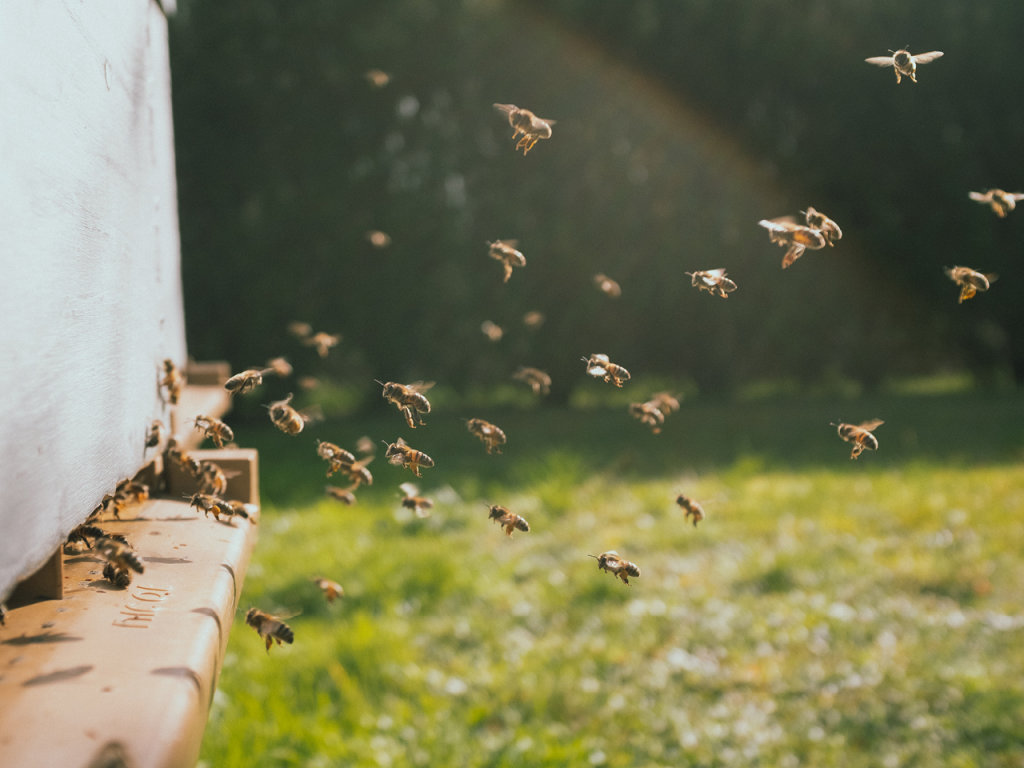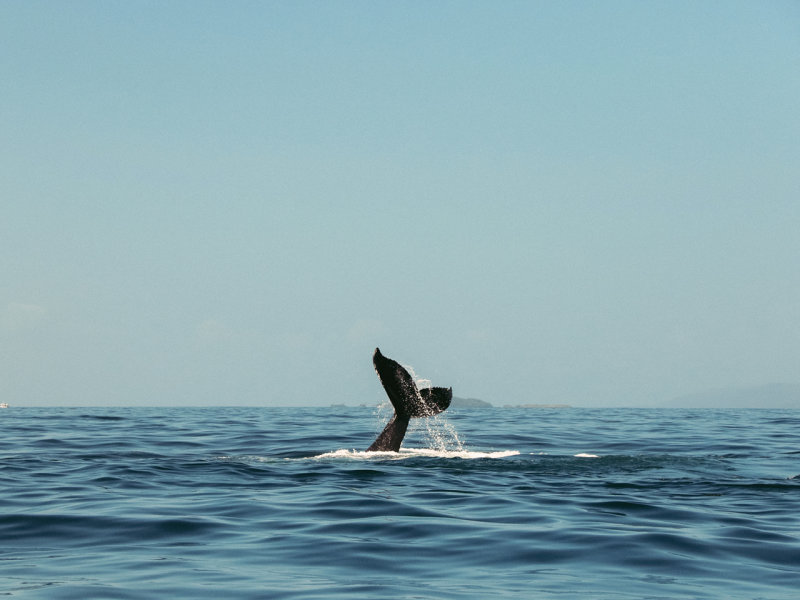Talking to each other is always good. And talking to each other about the climate and sustainability is even better – because there is so much that needs to be talked about. That’s why we’ve picked out 10 facts for you that you can share with friends, use to break the ice in awkward small talk situations and even awaken the curiosity of people who don’t usually take an interest in climate matters. So let’s dive right in!
Yes, small talk can be annoying – but it’s also entertaining! And if you can also learn something new from it, then all the better, right? Because every conversation about the climate and our planet is an opportunity to inspire change. We’ve compiled 10 facts that will help you easily start a conversation and you might even learn a thing or two yourself. Everyone’s a winner!
1. Trees groan when they don’t have enough water
It’s not only us humans who moan and groan when the temperatures rise: when they are lacking water, trees also make noises, albeit ultrasonic ones that are too high-pitched for the human ear to pick up. Whenever there is strong evaporation through a tree’s needles or leaves, a negative pressure is created that sucks the liquid upwards into the vessels. During longer, dry periods, the tension in the liquid and the vessels increases and a cavitation bubble is created. When the water column breaks, the vessel walls oscillate back and forth a few times, creating ultrasonic waves – which sounds like the tree is groaning or sighing. The repercussions of the climate catastrophe and severe periods of drought on the survival of forests can therefore be proven with non-invasive ultrasonic sensors.
2. Even before meat, cheese and chocolate: butter is the biggest climate sinner
All you butter lovers out there need to be strong: to make one kilo of butter, around 24 kilos of gases that are harmful to the climate are released, a mix of CO₂ and the even more damaging methane. It takes 18 liters of milk to make one kilo of butter. Just to put this into proportion: in 2021, 510,000 tonnes of butter were consumed in Germany. The fact that meat usually has a lower impact on the climate than butter is due to its shorter lifespan and the lower methane emissions of the animals. However, we usually eat a lot less butter than we do meat: in Germany, around 60 kilos of meat are consumed per person each year, while butter consumption, on the other hand, is just one tenth of that. Yet the production of butter is more time-consuming and energy-intensive, and the packaging, transport and energy-intensive food cooling chains also need to be taken into consideration. If you don’t want to completely forgo butter and make the switch to margarine, you could at least try to use it more sparingly.
3. By the year 2050, almost every species of seabird in the world will have to ingest plastic
Sea creatures often mistake the ever-increasing amounts of plastic waste in the oceans for a proper source of food. But why is that? The algae and bacteria that coats the plastic debris floating in the water emit dimethyl sulfide (the typical scent of the sea) in such high concentrations that seabirds can smell it. And it can often be found in higher concentrations than we would expect in oceanwater. The birds are lured by the smell of the plastic waste, even from large distances. A study showed that by 2050 a whopping 99% of ocean inhabitants will be affected – from the miniscule zooplankton to fish, turtles and seabirds down to the biggest whales. The birds end up eating the indigestible bits of plastic which, worst case, take up so much room in their guts that they can’t consume enough food to stay healthy. To prevent this pollution, we need to drastically reduce the plastic waste in the world’s oceans.
4. Wealthy people are excessively harming the environment
The excessive consumption of an affluent minority is fueling the climate catastrophe, as revealed in the 2020 Oxfam study entitled Confronting Carbon Inequality. The richest 10% of the world’s population (630 million people) were responsible for more than half (52%) of the cumulative CO2 emissions between 1990 and 2015. The richest 1% alone were responsible for 15% of emissions, the poorest half for just 7%. Although their contribution to the climate catastrophe is small, they are the ones who are most affected by its repercussions such as floods, storms and droughts. Oxfam’s report once again shows that we need to fight for social and economic justice for everyone if we want to combat the climate crisis. The keyword here is climate justice: the countries that carry the main responsibility for global warming (the Global North) urgently need to take more global responsibility for the damaging effects of climate change (mainly in the Global South).

5. You have to do the mileage first: e-cars aren’t automatically better than cars with internal combustion engines
Electric cars are often advertised as being emission-free. But that’s not quite true because the cars and their batteries need to be made and then also disposed of at some point and the electricity to charge them needs to be generated – resulting in emissions in mining, manufacturing and power plants.
Unlike cars with an internal combustion engine, the main environmental impact of electric cars is caused during the production of the vehicles themselves. The CO₂ emissions generated during their production can be balanced out by driving the electric cars – the cleaner the electricity, the faster this will happen. Every year, the average German covers a distance of 11,387 km by car. The CO₂ footprint disadvantage of an electric car is offset, depending on the model, after it has been driven 28,000 to 100,000 kilometers. Only then do we start seeing the CO₂ advantage over conventional combustion vehicles. But it definitely pays off in the long term so it’s worth making the switch. But we also need to remember that public transport, cycling and walking are still the most environmentally friendly alternatives for getting from A to B.
6. Household appliances in stand-by mode make up around 10% of the average electricity bill
TV, Bluetooth speakers, electric toothbrush and of course our mobile phone charger that’s plugged into the socket even when it’s not being used: many of our electronic devices are permanently on stand-by. Households with a lot of older appliances in particular often have unnecessarily high electricity bills because of this stand-by mode, not to mention the high CO₂ emissions it causes. Depending on the bill and the devices, a two-person household can save approx. €60 in energy costs and also plenty of CO₂ every year by switching off the stand-by function. So it’s worth having a look for all those little lights that are always on around your home and turning the appliances off at the wall.
7. The honeybee: a little animal that ensures our survival
It’s amazing what bees can do! These agricultural animals generate around €2 billion euros a year for the economy. And they are also a source of food for other animals such as birds. In Germany, the honeybee is the third most important agricultural animal (after pigs and cows). The German Beekeepers Association estimates that the number of bee colonies has decreased from 2.5 million to 1.4 million in the past 67 years. That is also down to the rise in industrial agriculture, the use of pesticides and the destruction of important habitats, by monocultures for example, the practice of growing just one crop species in a field at a time.
As well as honey, fruit, vegetables, fruit juices, fruit gummies, oils, spreads or clothing made of cotton are also affected by the loss of bee colonies as bees pollinate the plants when they fly from flower to flower. It is estimated that one to two thirds of our food are dependent on pollination by bees.
Wild bees like bumblebees or wasps are therefore protected and can neither be caught nor killed. So what can we do? We can help by planting wildflowers and buying organically grown food products wherever possible.

8. Veganuary saves around 104,000 tonnes of greenhouse gas emissions
Combating the climate crisis by going vegan: every year, non-profit organization Veganuary encourages people all over the world to try out a purely plant-based diet in January and beyond. More than two million people have officially signed up since Veganuary was first established in 2014. 629,351 people from almost all countries in the world signed up on the website to take part in Veganuary 2022 (only Tajikistan and North Korea weren’t on the list). The results of a study by Harvard University show the positive impact that one million Veganuary participants have already achieved:
They have saved just under 104,000 tonnes of CO₂ equivalents – which is equivalent to driving around the world almost 15,000 times.
They have saved approx. 6.2 million liters of water – which is equivalent to flushing the toilet almost half a million times.
And 3.4 million fewer animals were required for animal production and therefore saved from slaughter.
These numbers will have since increased even more as the number of Veganuary participants is growing every year and we can assume that a lot more people take part in Veganuary than officially sign up via the website.
9. Every German person throws away 78 kg of food each year
In June 2022, the Federal Statistical Office of Germany calculated and reported approx. 11 million tonnes of food waste to the EU Commission for 2020. The majority of this waste (59%), which is equivalent to 6.5 million tonnes, comes from private households, which as well as leftovers also includes nut shells, fruit peelings and bones. These food items were produced, mostly packaged in plastic and then end up unused in landfill. 65% of this food waste is thrown away for no reason, simply because it is slightly damaged or just past its use-by date. Every consumer throws away around 78 kilograms of food each year.
10. A whale captures more CO₂ than thousands of trees
When it comes to capturing CO₂ emissions, one whale is worth more than thousands of trees. Marine biologists have discovered that whales – especially great whales – play an important role in capturing carbon from the atmosphere. The carbon capture potential of whales is astonishing: whales accumulate carbon in their bodies during their long lives. When they die, they sink to the bottom of the ocean. Throughout their lifetime, a great whale sequesters 33 tonnes of CO2 on average, taking that carbon out of the atmosphere for centuries. A tree, on the other hand, absorbs only up to 21 kg of CO₂ a year. Protecting whales could make a significant contribution to carbon capture because the current population of the largest great whales is only a small fraction of what it used to be.
